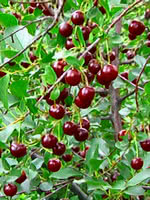Mon-Fri 9am - 5pm Mountain time
Cupid Cherry vs Japanese Quince
Prunus x kerrasis Cupid
Chaenomeles japonica
NOT AVAILABLE THIS SEASON - MIGHT RETURN
NOT AVAILABLE THIS SEASON - MIGHT RETURN
Cupid Cherry is a hardy deciduous hybrid shrub variety of Sour Cherry released in the Romance Series of dwarf sour cherries from the University of Saskatchewan in 2004. Cupid Cherry produces the largest fruit of all the sour cherries which is dark/red fruit and perfect for fresh eating but it tends to be a bit later than other varieties.
Japanese Quince has bright, orange to red showy flowers that bloom in early spring. The flowers appear before the leaves and may continue to bloom after leaves emerge. Flowers grow on old wood, so pruning after flowering will help to promote new growth next spring. They produce yellow-green fruit that taste bitter when eaten raw, typically they are better suited for making preserves.
It can be used as a stand alone ornamental shrub, as a low hedge, or can be trained to grow against a wall. In late winter, branches of Japanese Quince can be cut and brought indoors where they will bloom on their own. They are deer and rabbit tolerant. The branches are spiny making them well suited for keeping unwanted wildlife away.

